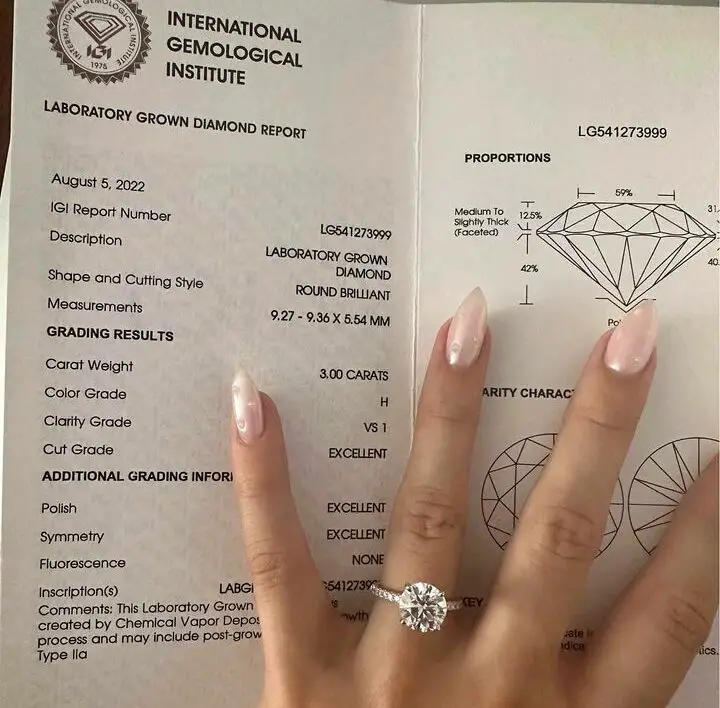Diamond Pavilion: How the Pavilion Affects Value and Impacts Brilliance
The pavilion is one of the most important parts of a diamond’s anatomy, yet it is often the most overlooked. Located on the bottom of the stone, the pavilion is not visible when the diamond is set in jewelry.
However, this region has a major impact on the stone’s brilliance, scintillation, and value.
Read on to learn about the different facets that make up a diamond’s pavilion and how they influence the light performance and beauty of the gem.
What is a Diamond’s Pavilion?
The pavilion refers to the lower section or backside of the diamond, extending from the girdle down to the culet. This region is composed of multiple triangular and kite-shaped facets that channel light back up through the top of the stone. The number and angle of these facets determine how well the diamond reflects and refracts light.
The three main components of the pavilion are the girdle, pavilion main, and culet. When you look at the face-up side of a diamond, the pavilion is not visible. However, its optimal design and precision are absolutely vital for maximizing sparkle and fire.
Anatomy of a Diamond’s Pavilion
Now, let’s examine the different parts of the pavilion in greater detail.
The Girdle
The girdle is the dividing line between the crown above and the pavilion below. It is the widest part of the diamond. The girdle’s purpose is to protect the edges and corners of the stone. Traditionally, the girdle was left with a bruted or rough, unpolished texture. However, most modern diamond cutters choose to polish the girdle as well to maximize light return.
The thickness of the girdle influences durability. An extremely thin girdle risks chipping, especially on diamonds with large culets. Conversely, a girdle that is too thick can look unsightly and detract from the stone’s brilliance. The ideal girdle thickness for a round brilliant-cut diamond is around 1.8% of the stone’s diameter.
The Pavilion Main
The pavilion main refers to the lower main facets that surround the culet. These large triangular and kite-shaped planes comprise the bulk of the pavilion. The key measurement is the pavilion main angle, which typically ranges from 40.6 to 41.8 degrees on a modern round brilliant diamond. This angle, along with the table size and crown angle, determines the diamond’s depth percentage.
An ideal depth percentage for a round brilliant diamond is between 58-62.9%. The pavilion’s main angles have the greatest influence on light return. If they are too steep, light leaks out of the sides of the diamond. If they are too shallow, light leaks out of the bottom. The optimal angles for maximizing brilliance and fire depend partly on the refractive index of the diamond.
The Culet
The culet is a tiny flat facet on the very bottom tip of the pavilion. The role of the culet is to prevent damage to the tip and protect the longevity of the diamond. In the past, large culets were commonplace. However, they can act like a window and allow light to leak out, reducing brilliance. For that reason, modern diamond cutters try to make culets as small as possible.
An ideal culet should be straight and aligned with the table facet. On most diamonds today, the culet is so tiny it is barely visible. Some diamonds are even cut with no culet at all. However, the lack of a culet does increase the risk of damage over time.
Popular Pavilion Styles and Cuts
There are many different diamond cuts, but certain ones dominate the market. Here are some of the most popular pavilion styles.
Round Brilliant Cut
The round brilliant is by far the most popular diamond shape, making up approximately 75% of diamonds sold today. This cut has a circular outline and features 58 facets including the pavilion.
Round brilliant diamonds are prized for providing the most optimal light return and face-up appearance. Their 360-degree symmetrical shape also means they conceal inclusions well.
The pavilion facets are strategically cut at precise mathematical angles to create optimal light diffusion and brilliance. Overall, the round brilliant cut allows diamonds to achieve the highest fire, brilliance, and appeal.
Fancy Cut Pavilions
While the round brilliant reigns supreme, other fancy cuts make up the remaining 25% of the diamond market. Some popular fancy shapes include:
Princess Cut: This square cut has a pavilion similar to a round brilliant, with four beveled sides. The princess cut shows off brilliance, sparkle, and the true color of the diamond. However, inclusions are easier to see.
Cushion Cut: Cushion cuts have large, open facets and rounded corners. The pavilion also has large facets to maximize fire and brilliance. This cut has an antique look.
Emerald Cut: Known as a step cut, the emerald cut has rectangular facets that resemble a staircase. Light does not reflect as much internally, so it showcases the diamond’s clarity.
Radiant Cut: Radiant diamonds combine the rectangular shape of an emerald with the brilliance of a round. The straight edges contrast with the faceted corners.
Pear Cut: This elegant teardrop shape combines a round or oval crown with a single point. The pavilion mirrors an inverted round brilliant cut.
Oval Cut: As the name implies, this popular elongated shape is essentially a stretched brilliant round diamond. It also has excellent light diffusion like a round.
Marquise Cut: The football-shaped marquise cut has pointed ends and curved sides. Its long shape can create the illusion of greater size.
Fancy shapes display the diamond’s color more than rounds, but lose some degree of brilliance. The cut proportions also require careful precision. Overall, the round brilliant offers the best combination of brilliance and value compared to other shapes.
How Pavilion Affects Diamond Brilliance and Value
Light performance is hugely impacted by pavilion depth, angles, symmetry and alignment. Well-cut diamonds have light return concentrated in a smaller area, creating more scintillation and contrast. The round brilliant cut, with its optimal pavilion, produces unmatched light return compared to other shapes.
Cut is considered one of the Four Cs of diamond quality—along with carat, color and clarity. A higher grade of cut means a better price. Diamonds with Excellent or Very Good cut grades command substantially higher prices than those with Fair, Poor or Ideal grades. This is because proper angles and facets optimize the internal reflection and refraction of light.
How to Select a Diamond Based on the Pavilion
Since the pavilion is invisible to the naked eye, how do you judge the quality of the cut? Look for these characteristics:
Ideal Proportions: A diamond grading report from a respected laboratory like GIA or AGS will list the exact measurements of the crown, pavilion, table, culet, girdle, etc. Make sure these align with recommended proportions.
Light Return: Diamond testers can map out the pavilion and simulate how well a diamond reflects light. High quality diamonds show even light return, not leakage.
Durability: Request the girdle thickness. A very thin girdle risks chipping. An ideal girdle thickness is around 1.8% of diameter.
Cut grades of Excellent or Very Good denote ideal polish, symmetry, and alignment of facets, with Excellent being the highest cut grade.
The Optimal Pavilion Proportions
Each diamond shape has its own ideal pavilion angle and depth measurements to achieve optimal light performance and sparkle. Here are some general guidelines for popular diamond shapes:
1. Round Brilliant Cut:
- Ideal Pavilion Angle: Around 40.6 to 41.2 degrees.
- Ideal Pavilion Depth: Typically around 43% to 44.5% of the total depth.
2. Princess Cut:
- Ideal Pavilion Angle: Approximately 39 to 41 degrees.
- Ideal Pavilion Depth: Often around 68% to 72% of the total depth.
3. Emerald Cut:
- Ideal Pavilion Angle: Typically between 40 and 45 degrees.
- Ideal Pavilion Depth: Generally around 60% to 70% of the total depth.
4. Asscher Cut:
- Ideal Pavilion Angle: Similar to the emerald cut, usually between 40 and 45 degrees.
- Ideal Pavilion Depth: Typically around 60% to 70% of the total depth.
5. Radiant Cut:
- Ideal Pavilion Angle: Usually around 41 to 43 degrees.
- Ideal Pavilion Depth: Often in the range of 61% to 68% of the total depth.
6. Oval Cut:
- Ideal Pavilion Angle: Approximately 40 to 42 degrees.
- Ideal Pavilion Depth: Generally between 60% and 65% of the total depth.
7. Marquise Cut:
- Ideal Pavilion Angle: Often around 40 to 42 degrees.
- Ideal Pavilion Depth: Typically between 50% and 58% of the total depth.
When shopping for a diamond, look for diamonds with pavilion measurements that fall within or close to the recommended ranges for their respective shapes. Be sure to check the diamond’s certificate, which should provide information on its proportions and cut quality.
*These are general guidelines, and there can be some variation based on individual diamond characteristics and the specific cutter’s preferences. Additionally, different laboratories and grading institutions may have slightly different ideal ranges.
FAQs About a Diamond’s Pavilion
Let’s review some common questions about the pavilion of diamonds:
How is a diamond pavilion different than the crown?
The crown refers to the upper section of a diamond above the girdle. The pavilion is the lower section below the girdle. The crown has the table facet and bezel facets. The pavilion has the pavilion main, culet and other smaller facets.
Do all diamond shapes have pavilions?
Yes, every diamond has a crown and pavilion, regardless of the shape. Round brilliant, princess, cushion, emerald cut, and all other diamond cuts have a pavilion. The number and angle of facets may differ based on the cut.
Does the pavilion impact the carat size of a diamond?
No, the pavilion does not change the diamond’s carat weight. The carat weight is based on the total mass. However, optimal pavilion angles and depth can affect the visible face-up size. Well-cut diamonds can appear larger.
What is the most brilliant pavilion?
The optimal pavilion design for maximizing brilliance is the round brilliant cut. Its precise mathematical angles and symmetrical shape reflect the most light and create unmatched fire and sparkle.
Can a poorly cut pavilion be fixed?
Yes, a poorly cut pavilion can be re-cut to improve light performance. However, this process will slightly reduce the diamond’s carat weight. The skill of the cutter determines how much brilliance can be restored.
How do I know if the pavilion angle is correct?
A diamond grading report will list the exact pavilion angle. For a round brilliant diamond, the ideal pavilion angle is between 40.6 to 41.8 degrees. Angles outside this range will negatively impact light return and brilliance.
Does the pavilion impact durability?
Yes, a very thin girdle risks chipping and a large culet is more prone to damage. Ideal pavilion proportions increase durability. The thickness of the girdle is especially important. An ideal girdle is around 1.8% of the diamond’s diameter for maximum durability.
Key Takeways
A diamond’s pavilion refers to the lower part of the diamond that sits below the girdle. The pavilion’s facets reflect light and enhance the overall brilliance and sparkle of the diamond, making it even more captivating.
The girdle, pavilion main, and culet work together to create optimal brilliance and fire. Slight deviations from ideal angles and depths can significantly impact light leakage.
When selecting your diamond, pay close attention to the cut grade and proportions of the pavilion. Combined with an appropriate setting style, a precisely cut pavilion will unleash the diamond’s full beauty.


